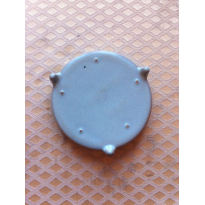After the rain, the sky is green and the clouds are broken.
This kind of color creates the future
——Ru Kiln I know
China's five famous kilns: Ru, Guan, Ge, Jun, Ding kiln, "Ru kiln is the leader", Ru kiln ranks first, I believe many people have heard of it, but the background of the times, artistic characteristics and value of its production are not what ordinary people can understand.
Ruyao is a place called Ruzhou near Kaifeng, the capital of the Northern Song Dynasty. It also burns royal porcelain here, hence the name. The site of the kiln is Qingliang Temple in Baofeng County, Henan Province.
In the early palace of the Song Dynasty, Ding kiln white porcelain was used, but the mouth was not beautiful. Finally, Emperor Huizong of the Song Dynasty chose your utensils for the imperial use as porcelain for the royal aristocrats.
Zhao Ji, Emperor Huizong of the Song Dynasty, as a literati emperor, liked art and was good at calligraphy, and his artistic skills were extraordinary.
Ru porcelain was burned for about 20 years during the reign of Emperor Huizong of the Song Dynasty. It is said that there are very few products in the world today, only about 100 pieces, so they are very precious.
There is no big device in your kiln, and it is generally a small handle. After the emperor created the sample, the kiln was specially provided according to the style. I can't use it!
Ruci is famous all over the world for its simplicity.
The Northern Song Dynasty was a dynasty that worshiped literature and suppressed martial arts. The literati were deeply influenced by the philosophy of interpretation. They advocated natural simplicity, simple style, and aesthetics were its characteristics.
The blue sky of Ru kiln is characterized by blue with blue in the middle. The light blue after the dusk rain is the sky blue. Tianqing is also a special color for Taoists!
Ru kiln glaze water is added to agate, so it is particularly expensive. The fine glaze water of the fetal body is thin, the crystal refractive index, and the color seen from different angles will change. It is quiet and elegant, and the warm glaze is lovely.
Another feature of Ru kiln is the dense opening of the table called "crab claw pattern", which is a small crack that scatters from porcelain under the change of room temperature for a long time.
The long-standing lines are darker and longer, the newly listed ones are shorter, and the color is lighter. This column grows over time and has the same vitality as the root of a tree.
Ruyao's fragrant gray fetus is characterized like the deep gray of the powder just burned by the incense branch, which is smooth and soft.
The kiln is full of glaze, and the whole device is full of glaze. At the bottom, you can often see three or five small nail marks like sesame seeds, which is a very obvious technological feature of the times.
In the microscopic aspect, the bubbles are very dense and transparent, and the bubbles have white cloud rings, which is difficult to master in modern technology. No wonder the Emperor Qianlong of the Qing Dynasty sighed that "Your kiln is absolutely nothing in the world".
In a word, Ru Kiln is a world-rich in its elegant and simple, subtle and warm glaze color.
Collectors will look at five aspects of porcelain: tire, glaze, shape, workmanship and quality. Of course, with the charm of the old era!
True, refined and rare are the standards of value, and the second is artistic achievements.
Ruyao's well-known collections include: three-legged washing, daffodil plate and lotus flower warm bowl.
Author
Mr. Robert T Li graduated from the Economics Department of the University of Hong Kong and has served as the Head of Liability Insurance in the Greater China region for an international insurance company. He has a passion for traditional Chinese culture and enjoys collecting art. He is actively involved in promoting awareness of traditional Chinese culture, music, and art among young people. He can be contacted at litaichai@gmail.com.
Uploaded on 2024.4.4




